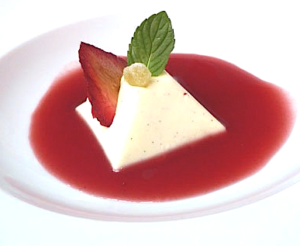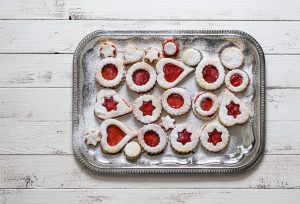them at precise, relatively low temperatures for long periods, may have
been largely in frozen convenience foods, but it has become standard in
top kitchens worldwide, notably Kellers own. With the publication of Under Pressure, Keller aims to
demonstrate the technique to a wider swath of cooks–not the masses, but
at least those who can afford this lavish volume and the sous vide
equipment.
 One need not cook the exact recipes (which are unaltered
One need not cook the exact recipes (which are unaltered
from the restaurants) to be inspired by Kellers careful yet whimsical
creations, such as a cuttlefish tagliatelle with palm hearts and
nectarine or squab with piquillo peppers, marcona almonds, fennel and
date sauce. And Keller, with several of his chefs as well as curious
cook Harold McGee, takes pains in the introduction to explain sous vide
fundamentals, arguing persuasively that it is not a fad but an
important technique that allows unparalleled control over how
ingredients are heated and what flavors and textures result.
Still, at
least until the equipment is more affordable, (see SousVide Supreme Water Oven) most readers will admire
this gorgeous book on their coffee tables, from the simple beauty of
photos of ingredients in their natural states to plates with a courses
elements so artfully arranged they would not be out of place in a
modern art museum.
The ground-breaking under-pressure method involves submerging food for minutes or even days in sealed, airless
bags at precisely the temperature required to produce perfect doneness.
Flavors and textures unattainable by other cooking methods can also be
achieved.
The technique has been in the pipeline for awhile–one
forerunner is the boil-in bag mom used to put veggies on the table–but
has only recently attracted top chefs. One is Thomas Keller, famed
chef-proprietor of The French Laundry and Per Se. His mightily sized,
gorgeously produced Under Pressure explores every inch of sous vide,
including the ramifications of using this precision-cooking technique
(once time and temperature are established, best results follow
automatically) on the craft of cooking, which has always meant a
potentially rewarding engagement with the possibility of failure.
The book makes no bones about being addressed to professionals. Typical recipes, like Marinated Toy Box Tomatoes with Compressed Cucumber-Red Onion Relish, Toasted Brioche, and Diane St. Claire Butter, involve multiple preparations and dernier cri ingredients, and thus resist home duplication. There’s also the matter of the pricey equipment required–chamber vacuum packers and temperature-maintaining immersion circulators–not to mention the precautions required to ensure that foods, usually cooked at low temps, are safe to eat.
What the book does offer the home cook is, however, thrilling. It
introduces something new under the sun–an exciting, transformative
technique of great potential. Anyone interested in food and
cooking–not to mention lovers of extraordinarily well produced
books–will want to explore Under Pressure


